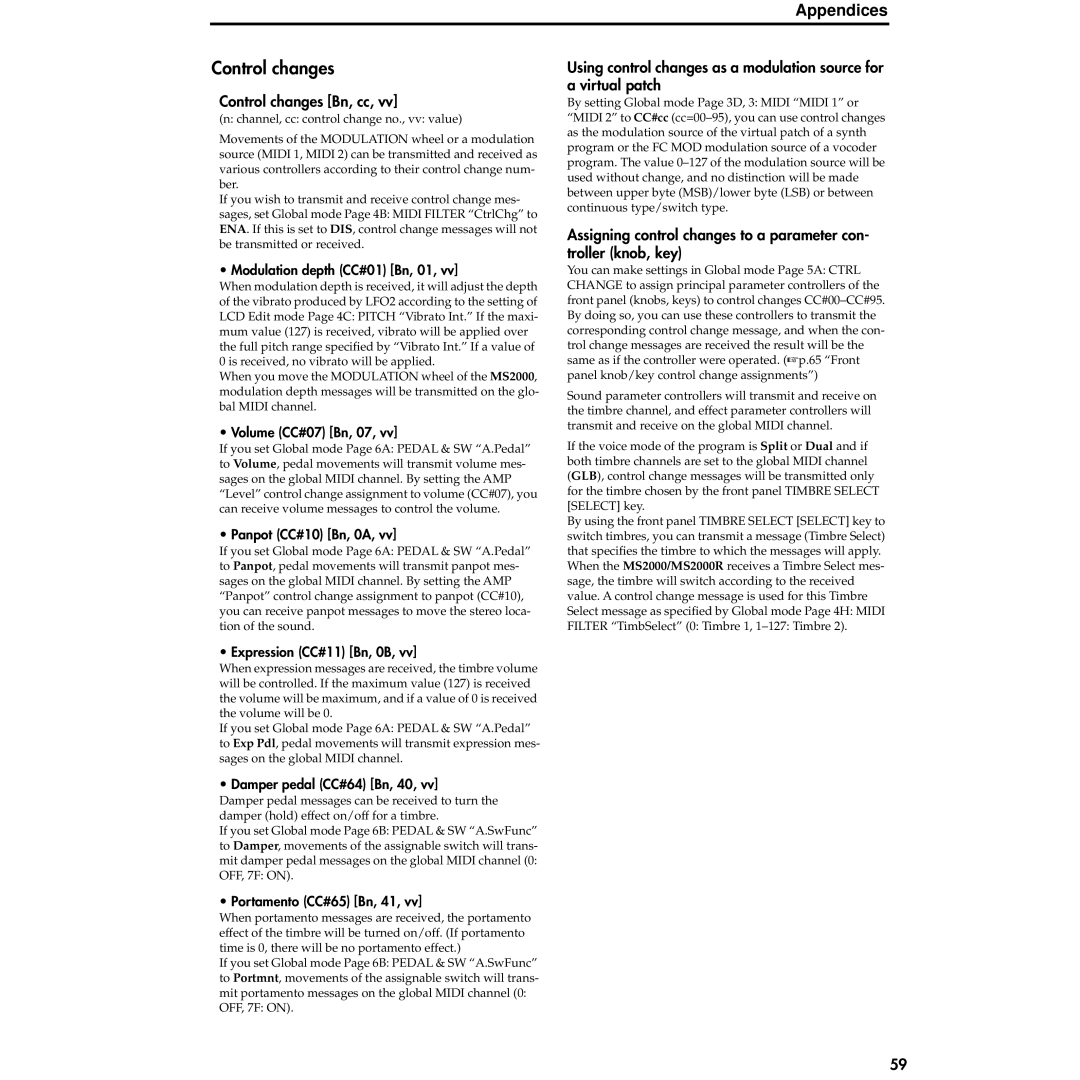Appendices
Control changes
Control changes [Bn, cc, vv]
(n: channel, cc: control change no., vv: value)
Movements of the MODULATION wheel or a modulation source (MIDI 1, MIDI 2) can be transmitted and received as various controllers according to their control change num- ber.
If you wish to transmit and receive control change mes- sages, set Global mode Page 4B: MIDI FILTER “CtrlChg” to ENA. If this is set to DIS, control change messages will not be transmitted or received.
• Modulation depth (CC#01) [Bn, 01, vv]
When modulation depth is received, it will adjust the depth of the vibrato produced by LFO2 according to the setting of LCD Edit mode Page 4C: PITCH “Vibrato Int.” If the maxi- mum value (127) is received, vibrato will be applied over the full pitch range specified by “Vibrato Int.” If a value of 0 is received, no vibrato will be applied.
When you move the MODULATION wheel of the MS2000, modulation depth messages will be transmitted on the glo- bal MIDI channel.
• Volume (CC#07) [Bn, 07, vv]
If you set Global mode Page 6A: PEDAL & SW “A.Pedal” to Volume, pedal movements will transmit volume mes- sages on the global MIDI channel. By setting the AMP “Level” control change assignment to volume (CC#07), you can receive volume messages to control the volume.
• Panpot (CC#10) [Bn, 0A, vv]
If you set Global mode Page 6A: PEDAL & SW “A.Pedal” to Panpot, pedal movements will transmit panpot mes- sages on the global MIDI channel. By setting the AMP “Panpot” control change assignment to panpot (CC#10), you can receive panpot messages to move the stereo loca- tion of the sound.
• Expression (CC#11) [Bn, 0B, vv]
When expression messages are received, the timbre volume will be controlled. If the maximum value (127) is received the volume will be maximum, and if a value of 0 is received the volume will be 0.
If you set Global mode Page 6A: PEDAL & SW “A.Pedal” to Exp Pdl, pedal movements will transmit expression mes- sages on the global MIDI channel.
• Damper pedal (CC#64) [Bn, 40, vv]
Damper pedal messages can be received to turn the damper (hold) effect on/off for a timbre.
If you set Global mode Page 6B: PEDAL & SW “A.SwFunc” to Damper, movements of the assignable switch will trans- mit damper pedal messages on the global MIDI channel (0: OFF, 7F: ON).
• Portamento (CC#65) [Bn, 41, vv]
When portamento messages are received, the portamento effect of the timbre will be turned on/off. (If portamento time is 0, there will be no portamento effect.)
If you set Global mode Page 6B: PEDAL & SW “A.SwFunc” to Portmnt, movements of the assignable switch will trans- mit portamento messages on the global MIDI channel (0:
OFF, 7F: ON).
Using control changes as a modulation source for a virtual patch
By setting Global mode Page 3D, 3: MIDI “MIDI 1” or “MIDI 2” to CC#cc
Assigning control changes to a parameter con- troller (knob, key)
You can make settings in Global mode Page 5A: CTRL CHANGE to assign principal parameter controllers of the front panel (knobs, keys) to control changes
Sound parameter controllers will transmit and receive on the timbre channel, and effect parameter controllers will transmit and receive on the global MIDI channel.
If the voice mode of the program is Split or Dual and if both timbre channels are set to the global MIDI channel (GLB), control change messages will be transmitted only for the timbre chosen by the front panel TIMBRE SELECT [SELECT] key.
By using the front panel TIMBRE SELECT [SELECT] key to switch timbres, you can transmit a message (Timbre Select) that specifies the timbre to which the messages will apply. When the MS2000/MS2000R receives a Timbre Select mes- sage, the timbre will switch according to the received value. A control change message is used for this Timbre Select message as specified by Global mode Page 4H: MIDI FILTER “TimbSelect” (0: Timbre 1,
59
